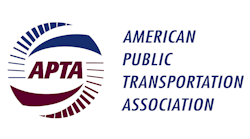Americans Took 10.1 Billion Trips on Public Transportation in 2017
Americans took 10.1 billion trips on public transportation in 2017, according to a report released by the American Public Transportation Association. Commuter rail and light rail ridership remained steady, with many public transit systems showing increases. Compared to public transit ridership in 2016, there was a 2.9 percent decrease in ridership as bus ridership declined by 4.3 percent.
“While we are in a time of great change, in part due to technological innovations, public transit remains a critical part of any community’s transportation network,” said APTA President and CEO Paul P. Skoutelas. “Public transportation organizations are revamping their services and experimenting with pilot projects to be more time and cost competitive, and more customer focused to meet the needs of today’s riders and the growing population.”
Public transportation is an integral part of the new mobility transportation system and public transit systems are partnering with other transportation companies to offer first mile and last mile transportation to public transit stations. In Tampa, Florida, Hillsborough Area Regional Transit has a program called HyperLINK. This innovative partnership between HART and a local transportation company provides rides to local bus stations within a three-mile radius. A customer can call HART or use the HyperLINK app to book a trip.
In addition, some public transit systems are increasing bus service in frequency and in hours of service, and achieving new efficiencies such as in demand-response service. In Phoenix and Seattle, recent efforts have resulted in increased bus ridership. Thanks to a successful ballot initiative, the city of Phoenix is considering increased bus service hours and frequency to match the rail service within the city. In Seattle, King County Metro has expanded bus service seven consecutive times since 2015 and has also increased the frequency of bus service at all times across many of its 200-plus routes.
Dallas Area Rapid Transit is currently reworking its bus network to better serve core riders with reliable 15-minute rush hour frequencies. DART is also making bus routes more direct and more complementary to its light rail system. The San Francisco Municipal Transportation Agency has added new routes, increased frequencies, and made changes to make bus routes more efficient, including consolidating some closely spaced stops. Muni is also adding new vehicles to replace their entire bus and light rail fleets.
Other public transportation systems are developing partnerships with community organizations to add new riders. In Albany, New York, the Capital District Transportation Authority has been able to keep ridership levels stable by placing emphasis on its growing Universal Access program with 20 partners from the education, health and service industries. This program accounts for more than 4 million trips annually, representing approximately 25 percent of CDTA’s annual ridership. In the past two years, UA ridership has increased by 50 percent.
To build customer loyalty and address the issue of cost competitiveness, the Washington Metropolitan Area Transit Authority has instituted the “rush-hour promise” for metro rail riders. If trips are delayed by 15 minutes or more, a customer will be offered a credit up to four times a month. Sacramento Regional Transit has reduced its K-12 Student Monthly Pass from $55 to $20 per month and has seen a 400 percent increase in K-12 Student Monthly Pass sales.
2017 Ridership Breakdown
Nationally, commuter rail ridership increased in 18 out of 29 transit systems while overall ridership decreased by 0.2 percent. With a new rail line that opened in February 2017, commuter rail in Denver, Colorado, saw an increase of 64.6 percent. The following two commuter rail systems saw double digit increases in 2017: Minneapolis, Minnesota (11.6 percent) and Portland, Maine (10.6 percent). Ridership in the following cities also saw increases in 2017: Salt Lake City, Utah (6.8 percent); Alexandria, VA (4.2 percent); Oakland, California (4.0 percent); Dallas-Ft. Worth, Texas (3.5 percent); Baltimore, Maryland (3.3 percent); Seattle, Washington (3.2 percent); Anchorage, Alaska (2.7 percent); Nashville, Tennessee (2.5 percent); Stockton, California (2.1 percent); Austin, Texas (1.9 percent); Pompano Beach, Florida (1.8 percent); Harrisburg-Philadelphia, Pennsylvania (1.1 percent); Boston, Massachusetts (0.10 percent); New York, NY-MTA Metro-North Railroad (0.1 percent); and New York, NY-MTA Long Island Rail Road (0.04 percent).
Light rail (modern streetcars, trolleys, and heritage trolleys) ridership increased in 11 out of 29 transit systems while overall ridership decreased by 0.8 percent. Systems that showed double digit increases in 2017 were in the following cities: Washington, DC (59.0 percent); Seattle, Washington – Sound Transit (20.9 percent); and Atlanta, Georgia (15.8 percent). Light rail ridership in the following cities also saw increases in 2017: Seattle, Washington – King County Dept. of Transportation (4.4 percent); Minneapolis, Minnesota (3.7 percent); Los Angeles, California (3.2 percent); Houston, Texas (3.2 percent); Charlotte, North Carolina (1.6 percent); Denver, Colorado (1.2 percent); Dallas, Texas (0.5 percent); and New Orleans, Louisiana (0.2 percent).
Heavy rail (subways and elevated trains) ridership decreased nationally by 2.1 percent. However, heavy rail in the following cities showed ridership increases for 2017: Jersey City, New Jersey – Port Authority of NY & NJ (5.3 percent); Lindenwold, NJ – Port Authority Transit Corporation (1.7 percent); and New York, NY – MTA Staten Island Railway (1.6 percent).
Bus ridership decreased nationally by 4.3 percent. The following cities showed the highest ridership increases at the nation’s large bus agencies: Phoenix, Arizona (6.2 percent); San Francisco, California (1.9 percent); Arlington Heights, Illinois (1.0 percent); and Seattle, Washington – King County Dept. of Transportation (0.2 percent).
Demand response (paratransit) ridership increased in 2017 by 0.4 percent.
A recent APTA report, Understanding Recent Ridership Changes: Trends and Adaptations, has analyzed the changing transportation ecosystem and its impact on public transportation. It has identified four categories of factors: erosion of time competitiveness, erosion of cost competitiveness, reduced customer affinity and loyalty, and external factors beyond the control of a public transportation system.


